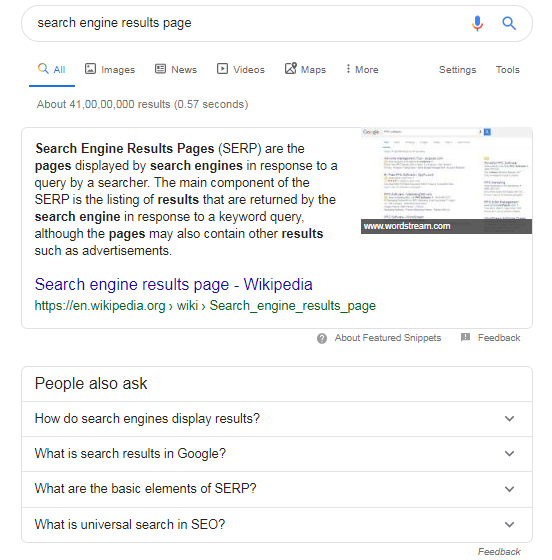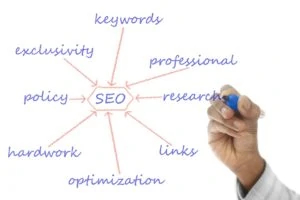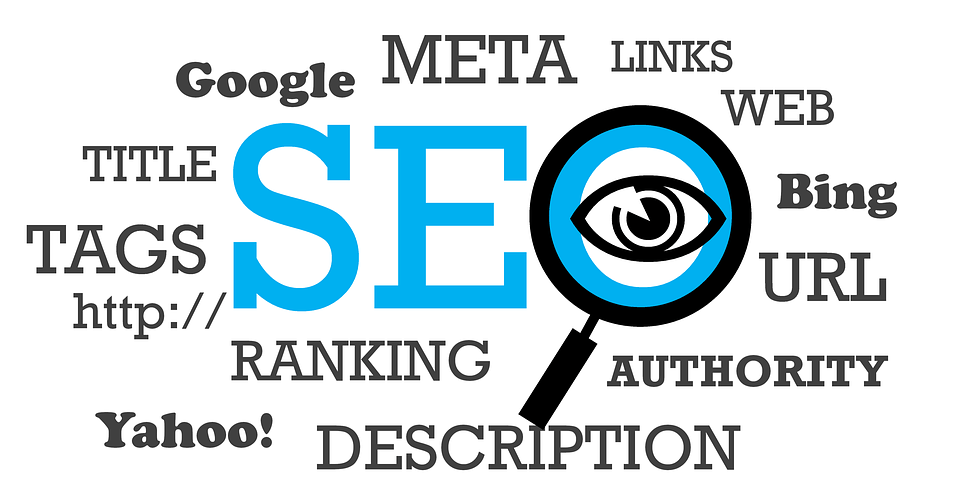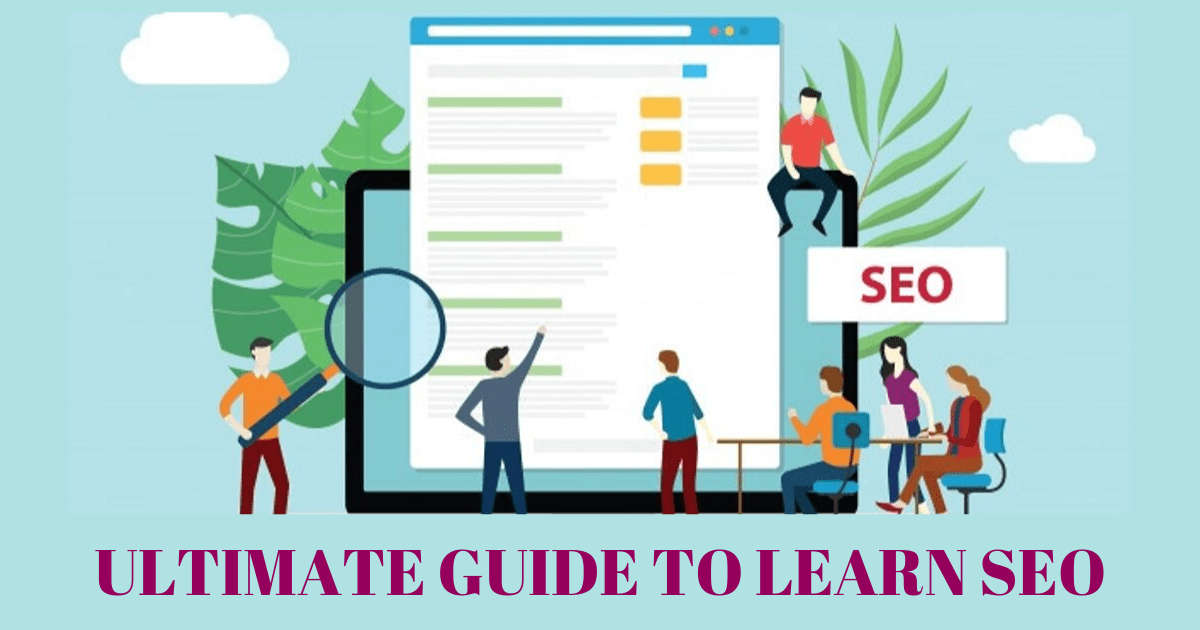Do you want to learn SEO?
Are you looking forward to building a career as an SEO expert?
You have landed on the right page.
This article will take you down the SEO lane to ensure that you learn SEO in the right way.
“No website can stand without a strong backbone. And that backbone is SEO.” – Neil Patel
In an era where textual, audial, and visual platforms are growing at an exponential rate, creating content that stands out has become extremely challenging. Individuals and businesses do not just have to focus on revenue enhancement anymore.
Instead, they are required to work towards gaining continuous online visibility, driving a steady stream of traffic and improving client conversion rates. This is why it comes as no surprise that a number of organizations and marketers are currently aiming to learn SEO and use it as a mechanism to form lasting connections with their customers.
On average, Google receives over 63,000 search queries, every second!
The SEO industry, in fact, has witnessed a massive growth spurt in the last few years. More and more businesses have begun to avail these optimization services in order to maximize their online footprint and increase their brand potential.
So much so that the SEO sector is expected to reach a humongous value of approximately $80 billion by 2020!
However, as a beginner in this arena, if you are wondering how to learn SEO step by step, here is a detailed guide which can help you decode the world of SEO better.
What is Search Engine Optimization?
Search Engine Optimization, often abbreviated as SEO, is a process that involves using a specific set of actions, methods, and procedures to help a website rank higher on the search engine results page (SERP).
A higher rank, by default, enables these websites to gain greater visibility and thereby, drive substantial traffic. The primary responsibility of SEO, therefore, is to ensure that the online position of a web page improves in an organic, non-paid, efficient, contextual and sustainable way.

Most marketing professionals decide to learn SEO because this comprehensive optimization technique instantly boosts their digital marketing efforts. More so, it also provides an extensive range of benefits like:
(a) Better user experience.
(b) Greater number of leads.
(c) Higher conversion rates.
(d) Measurable marketing outcomes.
(e) Improved cost management.
(f) Enhanced brand credibility.
(g) Increased market share.
(h) Growing business revenue.
As compared to traditional outbound methods with a meagre conversion rate of 1.7%, the conversion rate for SEO is a massive 14.6%.
Is It Tough to Learn SEO?
Learning SEO is not really a tough job. Any aspiring or working marketing professional can easily learn SEO step by step, within a short span of time. However, if you are truly willing to sail through the choppy waters of SEO, you will have to foster, imbibe and develop a couple of analytical, creative and technical skills.
Acquiring these skills would not just enable you to meet audience needs, navigate ranking algorithms or taste quick success, but it would also prepare you to beef up your career game and gain a decisive edge over your competitors.
For most practical purposes, there are two different ways to learn SEO:
1. Self-Study
2. Expert Tutelage
In case you choose to follow the first path, there is sufficient material available on the internet to guide you through the thick and thin of SEO. You can refer to blogs, write-ups, videos, e-books, courses, classes, webinars, and a variety of other informative tools. To top it off, most of these materials can be accessed at negligible cost.
Nonetheless, if you are running short of time or need to understand SEO basics in a quick, specialized, and targeted way, seeking expert tutelage might prove to be the best option for you. Experts, with their competence and experience, would be able to give you a detailed insight into the world of SEO, helping you gain mastery over it.
Although availing expert services through consultants, agencies, or specialists won’t be free of cost, it would certainly be worth all the effort.
What Are The Basic Terms to Learn SEO?
Before you embark on the task of learning SEO, it would be wise to familiarize yourself with a few terms and terminologies that constitute SEO basics. These are:
On-Page SEO
As the name itself suggests, on-page SEO implies making actionable changes on your website so that search engine rankings can be altered organically. It includes optimization tactics like:
(i) Keyword inclusion.
(ii) Headings and subheadings.
(iii) URL structure.
(iv) Meta description.
(v) Meta tags.
(vi) Content relevance.
(vii) Data structuring.
(viii) Image streamlining.
(ix) Website speed.
(x) Web page size.
Off-Page SEO
As opposed to its on-page counterpart, off-page SEO involves different activities that can be undertaken to improve website ranking without changing the core structure of the page. These include:
(i) Acquiring backlinks.
(ii) Social media marketing.
(iii) Influencer cooperation.
(iv) Guest blogging.
(v) V-logging.
(vi) Email outreach.
(vii) Guest submissions.
(viii) RSS feed subscription.
(ix) Forum posts.
(x) Document sharing.
High quality content and link building are the two most important signals used by Google to rank your website for search.
White Hat SEO
White hat SEO is an informal term used to define a set of ethical principles which involve the usage of SEO techniques, guidelines, and rules in a productive way. It is primarily constituted of:
(i) Well-written & relevant content.
(ii) Natural link insertion.
(iii) Brand building.
(iv) Overall website optimization.
(v) Well-researched keywords.
(vi) Focus on quality.
(vii) Effective content strategy.
(viii) Content analysis.
(ix) Focus on User experience.
(x) Inter-device operation.
Black Hat SEO
Black hat SEO, on the other hand, is an informal term used to define a set of unethical principles which are used to improve page rankings. However, if found out, black hat SEO users are most likely to be penalized. These practices include:
(i) Hidden text.
(ii) Link manipulation.
(iii) Keyword stuffing.
(iv) Cloaking page redirects.
(v) PBN farms.
(vi) Spam comments.
(vii) Irrelevant backlinks.
(viii) Auto-generated content.
(ix) Automated queries.
(x) Malicious behaviour.
Grey Hat SEO
Somewhere between the white and black hat SEO techniques, lies the grey hat SEO which can help you tread the thin line between optimization and penalization. It comprises acceptable tactics like:
(i) Website redesigning.
(ii) Social media sharing.
(iii) SEO squatting.
(iv) Using free AdWords.
(v) Charity links.
(vi) Cloaking non-relevant content.
(vii) Link chaining.
(viii) Paid reviews.
(ix) Content repositioning.
(x) Targeted paid directory.
When you venture on the path to learning SEO, understanding these five SEO basics would go a long way in helping you stay concentrated and focused.

How Do Search Engines Rank Websites?
“Some say Google is God. Others say Google is Satan. But if they think Google is too powerful, remember that with search engines, unlike other companies, all it takes is a single click to go to another search engine”. – Sergey Brin, co-founder, Google
If you are keen to learn SEO step by step, you need to first begin by targeting the SE (search engine) part of SEO. What are search engines really? How do they work and how do they go about tanking websites?
Search engines, in simple words, are software systems which identify specific items in a database and present them to the user in accordance with his or her textual query. For example, if a user searches for ‘schools near me,’ a search engine scans all the web pages containing the word ‘school’ and lists them on the basis of their geographical proximity to the user.
In order to do this, a search engine performs three basic activities:
1. Crawling: To begin with, a search engine sends out millions of small bots to crawl through various sections of a website. It scans keywords, content, hyperlinks, videos, images, headings and subheadings to detect items that correspond to the user’s search.
2. Indexing: Once the crawling has taken place, the search engine starts to index every web page that it has earmarked. These web pages are then catalogued in order of their importance to the search query. Indexing is the principal tool that determines visibility.
3. Displaying: Last but not least, search engines pick out relevant results by digging into the listed index. For doing this, they use a number of algorithms and check each query against different websites. Matching results are then displayed on the search engine results page (SERP).
At least 2 trillion searches are performed every year, with mobile being the most preferred medium for search!
Although search engine performance is important with respect to both, developers and users, it is always the users’ perspective which holds the greatest priority. Every investment made in the search engine market has to pass the test of retaining user interest.
This is why most professionals who want to learn SEO, simply rely on:
(i) Using search engines as a medium to find information or seek solutions.
(ii) Making sure that the search query has the right blend of keywords.
(iii) Distinguishing between paid ads and non-paid, organic search results.
(iv) Scanning the displayed websites for relevance and suitability.
(v) Going through the SERP updates and making subsequent changes.
At this juncture, it becomes vital to understand what SERP is and how its features can impact your search results.
What is SERP?
A Search engine results page (SERP) is basically a page that is displayed as a result of the user’s search query. This page contains all the relevant websites which are ranked in accordance with their importance. The listings on a SERP are never stagnant.
They continue to change whenever updates are made on the web page content or its underlying algorithms. Therefore, the cardinal responsibility of someone who intends to learn SEO step by step is to maintain a ‘zero position’, at all times.
This position can be maintained by adhering to the following content strategies
(i) Answer questions in terms of who, what, how, when, where, and why.
(ii) Provide bullet points or listicles with how to(s) or instructions.
(iii) Simplify complex terms by breaking them down into comprehensible parts.
(iv) Make comparisons to further facilitate the understanding process.
(v) Offer detailed answers to the most frequently asked questions.
A typical SERP tends to look somewhat like this:

As can be seen from the image above, SERP carries a number of visually appealing and informative features, which largely include:
(i) Featured snippets.
(ii) Images and videos.
(iii) A carousel of products.
(iv) Answer boxes.
(v) Top stories.
(vi) Map packs.
(vii) Knowledge graphs.
(viii) Events and ads.
(ix) Sitelinks.
(x) Sponsored features.
Knowing SERP would help you make an extensive SEO plan which can prove to be the focal point of all your digital marketing campaigns in the future.
What Are the Different Types of Search Queries?
Now that you are well-versed with the functioning of search engines and SERP, it would be wise to find out the different kinds of search queries that SEO marketers have to deal with on an everyday basis.
In general, there are three types of search queries. These are:
1. Navigational Search Queries:
A navigational search query conveys the intent of the user to navigate the internet in search of a particular web page or brand. For example, a lot of people search for ‘Facebook’, ‘YouTube’ or ‘Google’ on the search engine instead of directly visiting the website through a navigation bar.
2. Informational Search Queries:
As the name itself suggests, informational search queries are meant to seek out information from the internet. For instance, if a user wants to find out the recipe for making a pizza, his/her search query would entail keywords like ‘how to make a pizza’. Informational queries are the most commonly used search questions.
3. Transactional Search Queries:
Transactional search queries are usually made by users who are looking to buy a specific category of product or brand. These search queries tend to include keywords like, ‘where to buy’, ‘what is the price of’ etc. In most cases, these queries lead to the customers conducting an online transaction.
With the emergence of voice-based search assistants like Google, Alexa and Siri, the conventional search query templates have undergone a major transformation. As a result, people who are willing to learn SEO have also had to modify their knowledge in terms of ranking techniques, tactics and methodologies.
SEO Basics – Factors That Affect Rankings
“Optimize for what would happen IF you ranked, do not optimize TO rank”. – Will Critchlow, Founder & CEO, Distilled
Whenever you ponder upon ‘how to learn SEO,’ the first thing that comes to mind is the factors which enable optimization tools to rank a website higher.
Although most search operators like Google, Bing, or Microsoft do not reveal the precise algorithms they use for determining ranks, the most common factors that improve traffic and drive conversions are made public. These include:
Critical Factors
The factors on which you need to stress the most:
(i) Well-researched content that specifically targets each search query.
(ii) The use of relevant and qualified backlinks.
(iii) Unique and accessible content (text, audio or video).
(iv) Click-through rate (CTR) i.e. the number of users who click on a link.
(v) Domain authority, brand credibility and customer delight.
(vi) The average speed with which a web page loads.
(vii) Enhanced user experience and positive customer reviews.
(viii) The ability to function on multiple devices like desktops, laptops and mobiles.
Important Factors
The factors which might not be critical but are essential:
(i) The layout and design of the web page.
(ii) Optimized videos, text, and images.
(iii) Trustworthy hyperlinks.
(iv) Page sharing across different social platforms.
(v) Delivery of a personalized experience.
(vi) The relevance of topics and keywords.
(vii) The depth & structure of data and content.
(ix) Accelerated mobile pages (AMP) content.
(x) Secure communication in terms of HTTPS.
Impactful Factors
The factors which can give you a credible edge over your competitors –
(i) Site architecture and sitemap.
(ii) User-friendly URLs.
(iii) Content quality.
(iv) Link velocity.
(v) Website reputation.
(vi) Server location.
(vii) Reliability and readability.
(viii) Domain extension.
(ix) Traffic sources.

The factors mentioned above capture the SEO ranking process in detail while giving an insight into the bases which search engines cover when they rank web pages. However, as someone keen to learn SEO, you must ensure that you do not fall into the trap where manipulative factors like keyword stuffing, cloaking, hidden links, crawl errors, misleading content, sneaky redirects, or bad domain history are used.
Speaking of content now is the time to figure out which variety of content can help you taste lasting SEO success!
What Kind of Content Should You Create?
Apart from being SEO-friendly, the content that you create for your website/web page must be unique, original and engaging. For this purpose, you can use a multiplicity of content formats like:
1. Blogs
Blogs are basically a set of in-depth articles that contain detailed information about a specific topic in hand. As a source of promotion, they are immensely popular amongst SaaS businesses, e-commerce sites, travel pages, marketing companies and other service providers. These blogs must be:
(i) Fresh, conversational and thought-provoking.
(ii) Well-researched, data-driven and information-centric.
(iii) Relevant, readable and consistent.
(iv) Able to create value for the readers.
(v) Target both B2B and B2C activities.
2. Reviews
Be it restaurants, tourist places, films, theatres, books, or businesses – writing a review for any/each of them would help you gain instant traffic. Not only would they give you the opportunity to shape public opinion but they would also help you establish your website in the influencer marketing industry. For writing a good review, you should:
(i) Choose a topic of popular interest.
(ii) Prepare a detailed rating system.
(iii) Write an honest & engaging piece.
(iv) Create personal standards of quality.
(v) Stay productive and consistent throughout.
3. Infographics
As the name signifies, infographics are essentially a mixture of information and graphics. They aim to present the most complicated information in an extremely attractive and readable way so that users can instantly understand what is being conveyed. In addition to it, they are easy to download and share. A good infographic must:
(i) An interplay of data and design.
(ii) Use graphics, images, and charts to create a story.
(iii) Put forth only the most relevant data.
(iv) Be colourful and appealing.
(v) Contain small transcripts of indexable text.
4. Guides & Listicles
Although there a number of how-to guides available in a listicle format, including them as a part of your content strategy can immediately help generate leads. This is because owing to a paucity of time, most people do not read through full-fledged texts. Instead, they prefer to quickly browse the listicles and gather important information. Ideally, this content format should:
(i) Contain highly specific information.
(ii) Carry backlinks to improve shareability.
(iii) Use captivating headlines.
(iv) Stress on extraordinary facts.
(v) Enable users to interact and comment.
Still confused about SEO?
Here’s a comprehensive video to help you understand optimization better.
5. Case Studies
Case studies are a classic example of how you can attract readers by sharing new and unique information. This content format doesn’t just help developers share interesting data, but it also helps businesses reveal the results of freshly conducted experiments. A case study must:
(i) Be thoroughly researched.
(ii) Contain original and proven data sources.
(iii) Provide the details of the experiments conducted.
(iv) Narrate the solutions as a story.
(v) Bring out the human side of businesses.
6. E-Books
As a lengthy piece of content that is generally available in PDF, e-books are known for their ability to explain complex narratives in the most simplified form. However, as a marketing strategy, they need to be used only on occasions that demand clarity, lucidity and transparency. They should:
(i) Be written as a proper book.
(ii) Have a catchy design.
(iii) Be properly edited and proofread.
(iv) Imbibe keywords carefully.
(v) Provide relevant information.
7. Interviews
In order to learn SEO, understanding the appropriate use of interviews as a part of the content is a must. Interviews provide expert opinions in an easily readable way and help users gain better insights into the topic being discussed. They also bolster credibility and harbour a large shareable potential. An interview must:
(i) Carry the viewpoint of a thought leader.
(ii) Contain exclusive information.
(iii) Ask and answer pertinent questions.
(iv) Flow naturally.
(v) Be engaging and interesting.
8. Videos
Quite like their textual counterparts, videos as an audio-visual device work wonderfully well on the content writing platform. They are easy to view, quick to grasp and have the ability to greatly enhance reach. A video, nonetheless, should:
(i) Have a detailed transcript.
(ii) Be shot with professional equipment.
(iii) Be self-explanatory.
(iv) Contain enriching content.
(v) Value the user’s time.
Understanding the kind of content that your website requires is indeed one of the best ways to learn SEO step by step. However, you also need to consider another important aspect i.e. – Keywords.
Everything You Need to Know About Keywords
Keywords constitute a highly essential part of SEO basics. They are the principal words which when included in your content can help index the web page, rank it higher and thereby ensure that it gets an adequate amount of online exposure.
Keywords can be of various types, like:
1. Short-tail Keywords
Made of three or fewer words, these keywords have an extremely high search volume but a terribly low conversion rate. This is because short-tail keywords throw up generic information without detecting the user’s actual intent.
2. Long-tail Keywords
Consisting of more than three words, these keywords have a low search volume but a high conversion rate. This is because long-tail keywords are very specific. They instantly convey the user’s intent and direct him/her to the target page.
3. Descriptive keywords
Descriptive keywords usually tend to describe a certain product, brand, incident, or event. These keywords are simple yet detailed. They enable a user to navigate the search engine results page and find exactly what he/she is looking for.
4. Geo-targeting Keywords
As is quite clear from the name, geo-targeting keywords are based on precise geographical locations. They are generally focused on more local and proximal businesses. Despite a low search volume, they have a high conversion rate.
5. LSI Keywords
Latent semantic indexing (LSI) keywords are essentially the words revolving around the principal keyword. From the root word, they emerge as branches which help narrow down the search options and deliver the most relevant results.

While trying to learn SEO step by step, you will have to find out which keywords you should use in order to enhance your optimization capabilities. Though you are free to devise your own set of short-tail or long-tail keywords, the best places to seek help from are:
(i) Google suggestions (Auto-complete and related searches tab).
(ii) Keyword tools (free or paid).
(iii) Keywords being used by your competitors.
(iv) Social media.
(v) Quora, Wikipedia, Reddit, and other similar forums.
For more details about how to spot keywords and get your website to rank high on SERP, refer
So, if you want to know how to learn SEO, content creation and keyword research should automatically lead you to the next most important step – link building.
What is Link Building?
“The objective is not to make your links appear natural; the objective is that your links ARE natural” – Matt Cutts, Administrator, US Digital Service
Link building, in simple words, is the process of linking your page to another website that has a higher domain authority. By doing so, you don’t just drive traffic towards your homepage but you also ensure that your brand’s credibility is built. As these links are used by web crawlers to classify and index content, link building directly enables your website to become SEO-friendly.
In general, there are two types of links:
(i) Do follow links – Links which empower your page to get authority from the linking page.
(ii) No-follow links – Links which do not facilitate authority transition from one page to another.
A link that connects your website to another should be both informative and relevant. For instance, connecting the page of a clothing store to a blog that talks about electronics make no sense whatsoever.
Such irrelevant and disintegrated links can neither generate leads nor bolster conversions. On the contrary, they can possibly damage a brand’s hard-earned reputation.
Bearing this in mind, the major link building strategies that you can adopt to derive better SEO results should include:
(i) Placing links within the body of the main article, instead of pushing them in headers, footers, or sidebars.
(ii) Ensuring that backlinks with hypertext are available throughout the various sections of a specific website.
(iii) Writing relevant anchor text with a fresh, unique, and engaging perspective.
(iv) Posting quality content, as a guest, on another similar website and using it to bolster customer-centric interactions.
(v) Devising personalized web links which do not fit into the typically used templates.
(vi) Analyzing the backlinks of competitors to find out how your links can be made more assertive and efficient.
(vii) Creating content that harbours the potential to go viral and get referral traffic, so that links are naturally attracted to it.
(viii) Using the services of expert PR professionals to build links via paid reviews, testimonials, and campaigns.
(ix) Ensuring that none of your listed backlinks is associated with any shady networks or spam websites.
As someone who intends to learn SEO, understanding the details of link building would certainly help advance your level of professionalism and expertise. Nevertheless, there is another facet of optimization which you need to focus on, in order to enhance your capability as a marketer. This facet is what is commonly referred to as – UX or User Experience.

What Is UX in SEO?
UX or user experience is basically the interaction which occurs between a user and a website on a regular basis. It assesses how the user feels when he/she logs in to a site and how he/she responds to the product or brand placement. In an ever-changing world, boosting UX is a continuous process which focuses on creative, as well as technical aspects.
75% of users never really go past the results displayed on the first page of SERP! So, if you want to grab their attention, that is exactly where you ought to be.
The kind of experience that a user has on a certain website depends entirely on a set of pre-defined factors. These are:
(i) The structure of the website.
(ii) Ease of navigation.
(iii) Availability of sitemap.
(iv) Quick and simple onboarding.
(v) The speed with which the page loads.
(vi) Conversion funnel optimization.
(vii) The responsivity of the page.
(viii) The relevance of content.
(ix) Headlines, title tags, and subheads.
(x) Instant grievance redressal.
(xi) 24 x 7 customer support.
(xii) Seamless and smooth workflow.
If the UX of a site can lead to customer delight, the conversion rate is bound to be higher. Therefore, learning UX writing enhancement while you learn SEO can often prove to be the best way to take a step higher up the career ladder.
How to Learn SEO – A Basic Checklist!
Now that SEO and all its interrelated domains are clear to you, it is time to go through a simple checklist of aspects which can help you further bolster your knowledge as you learn SEO step by step. These aspects are:
(i) Meta Tags – Consisting of meta descriptions and meta titles, meta tags describe web content. They are usually harboured in the HTML code.
(ii) Headlines – Meant to highlight the contents of a page, headlines shouldn’t just be attractive; they should also contain vital keywords.
(iii) Uniform resource locators (URLs) – Making URLs that correspond to the contents of a website without interfering with its structure is the need of the hour.
(iv) Multimedia – Comprising of images, videos, infographics, podcasts, webinars, and a variety of other tools, hosting multimedia files is currently the hottest marketing trend.
(v) Mobile Optimization – The webpage should be devised in such a way that it can be viewed with equal proficiency on any portable/non-portable device, especially mobiles.
(vi) Search Console – Using the services of Google to maintain, monitor, and track a website’s online performance, requires the initiation of a search console.

Frequently Asked Questions (FAQs)
Q1. What is better – Search engine optimization (SEO) or search engine marketing (SEM)?
A1. SEO, in itself, is a part and parcel of SEM – which is a larger marketing technique. SEM primarily includes SEO and PPC. PPC here stands for pay per click. SEO and PPC are both considered to be vital elements for the success of SEM because they create brand affinity, target prospective customers, analyze user behaviour, and establish domain authority. SEM, therefore, remains incomplete without SEO and PPC.
Q2. Is SEO changing?
A2. SEO is an ever-evolving technique. There was a time when mere keyword stuffing was considered to be enough. Now, not so much. With new technologies coming in, SEO is changing in terms of its relevance and usability. The greatest change, in fact, has been the shift towards mobile devices. Most SEO processes of the future will have to adapt to this shift.
Q3. How should I start building an SEO strategy?
A3. The first step to start building an effective SEO strategy is a site audit. Conduct a detailed check of your website and find out if there are any problems. At most times, broken links, crawl errors, keywords issues, and site speed get overlooked. Rectify these issues before building an SEO strategy.
Q4. What is anchor text?
A4. The clickable text on the hyperlink is largely referred to as anchor text. It is supposed to match the keyword with which it is linked so that it becomes easy for users to figure out where the hyperlink would lead them.
Q5. What can SEO do for a business?
A5. SEO can be a great asset in terms of lead generation, traffic increase, conversion boost, and revenue enhancement. The higher your website ranks on a SERP, the greater are your chances of tasting lasting success.
The Way Forward
As times change, the need to learn SEO has begun to gain massive importance. More and more individuals and businesses are taking to the optimization process in order to beef up their conversion rates and increase their earned revenues. This has led to a situation where the number of learners has far exceeded the number of mentors.
However, if you have the passion to learn SEO step by step & give an upward growth to your career, enroll in the Search Engine Optimization Course today.
After all, optimization is the key to building credibility and the success or failure of this key relies completely on your dedication!









